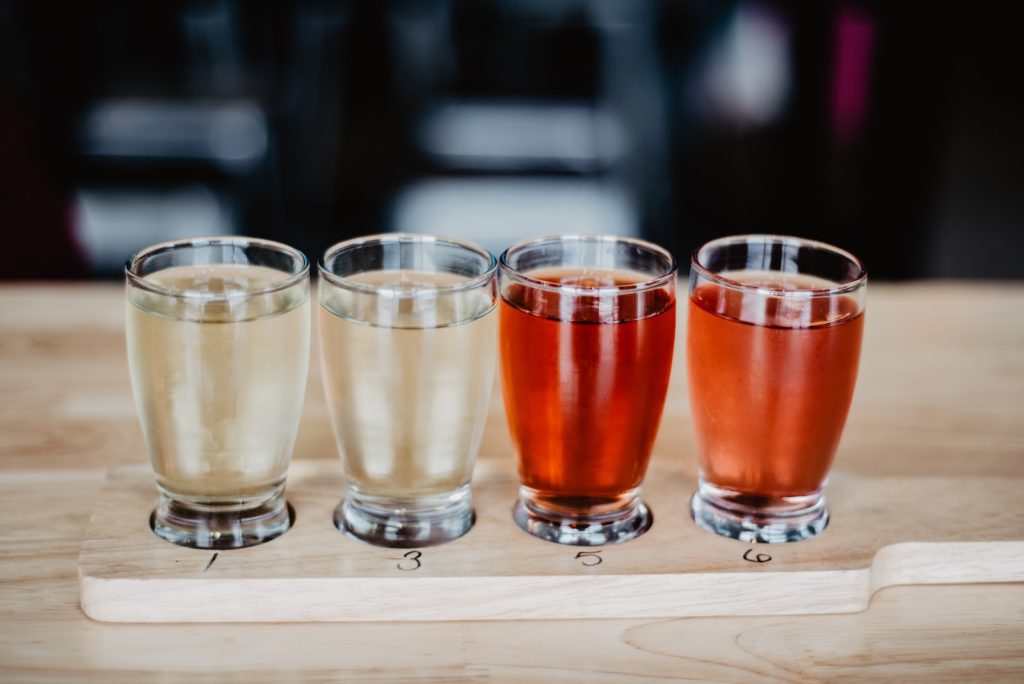Get ready to embark on a delicious journey through the wonderful world of dry ciders! Whether you’re a cider enthusiast or just curious about expanding your palate, this article will take you on a fascinating exploration. We’ll uncover the secrets behind the production process, dive into the different types of dry ciders, and discover the perfect food pairings for these crisp and refreshing beverages. So grab a glass, sit back, and prepare to be captivated by the dry truth of dry ciders.
History of Cider
Ancient Origins of Cider
Cider has a long and rich history that dates back thousands of years, with evidence of its production found in ancient civilizations such as the Egyptians, Greeks, and Romans. The origins of cider can be traced back to the cultivation of apple trees in Central Asia and the spread of apple cultivation throughout Europe by the Romans. Ancient civilizations used cider for various purposes, including religious ceremonies, as a currency, and for its medicinal properties.
Cider in Europe
Throughout history, Europe has been a prominent region for cider production. In the Middle Ages, cider became popular in regions like England and France due to favorable growing conditions for apple trees. In England, cider was a commonly consumed beverage, especially in rural areas. In France, cider production thrived in regions like Normandy and Brittany, where distinct styles of French cider emerged.
Cider in America
Cider played a significant role in the early days of American history. The first apple orchards were planted by European settlers in the 17th century, and cider quickly became a staple beverage. However, with the rise of beer consumption and the temperance movement in the 19th century, cider production declined. It wasn’t until recent years that the popularity of cider made a comeback in America, with an increasing number of craft cider producers and enthusiasts.
Defining Dry Cider
Understanding Cider Terminology
To understand dry cider, it’s important to familiarize yourself with cider terminology. Cider is typically classified based on its sweetness level, which can range from dry to sweet. Other commonly used terms include “tart,” “tannic,” and “effervescent,” which refer to different flavor characteristics of cider.
Differentiating between Sweet and Dry Ciders
The key difference between sweet and dry ciders lies in their sugar content. Sweet ciders have higher residual sugars, resulting in a visibly sweeter taste. On the other hand, dry ciders have less residual sugar, allowing the natural flavors of the apples to shine through. Dry ciders are often described as crisp, refreshing, and more similar to traditional European ciders.
Crafting Dry Ciders
Selecting the Right Apples
Selecting the right apples is crucial for crafting high-quality dry ciders. While specific apple varieties vary depending on the desired flavor profile, tannins, acidity, and sugar levels, some popular choices for dry ciders include bittersweet and bittersharp apple varieties. These apples provide the necessary balance of acidity and tannins, resulting in a well-rounded and dry cider.
The Fermentation Process
The fermentation process is a vital step in cider production. After the apples are pressed to extract the juice, yeast is added to initiate fermentation. For dry ciders, it is common to use wine or champagne yeast strains, which consume the sugars in the juice, converting them into alcohol. This process can take anywhere from a few weeks to several months, depending on the desired taste and style of the cider.
Blending and Aging Techniques
Blending and aging are techniques employed by cider makers to enhance the complexity and flavor profile of dry ciders. Blending involves combining different batches of cider to achieve a desired taste, balancing sweetness, acidity, and tannins. Aging the cider in barrels or tanks allows it to develop depth and character over time. Common aging methods include oak barrel aging, which imparts unique flavors and aromas to the cider.
Regional Varieties
Traditional English Dry Ciders
Traditional English dry ciders are known for their complex and robust flavors. They are often made from a blend of tannic and acidic apple varieties, resulting in a dry, yet flavorful, cider. English dry ciders often exhibit earthy and fruity notes, with a slightly astringent finish. They are best enjoyed chilled and paired with hearty dishes or cheese.
French Ciders: Normandy and Brittany
Normandy and Brittany in France are renowned for their unique cider production techniques and distinct cider styles. French dry ciders from these regions are typically made from a combination of bitter and acidic apple varieties, resulting in a well-balanced and nuanced flavor profile. French ciders are often known for their lively effervescence and rich fruity flavors, making them a delightful choice for pairing with seafood or light desserts.
Spanish Sidra: Asturias and Basque Country
In Asturias and the Basque Country of Spain, sidra, the local name for cider, holds great cultural significance. Spanish dry ciders, often served still and poured in a unique style called “escanciar,” have a bright and fresh taste. They are known for their natural cloudiness and acidity, which pairs exceptionally well with the region’s traditional cuisine such as grilled meats and tapas.
North American Dry Ciders
North America has seen a surge in dry cider production in recent years, with both traditional and innovative styles emerging. Incorporating a wide range of apple varieties, North American dry ciders showcase the diverse flavors of the continent. From the Pacific Northwest to New England, these ciders bring forth a balance of crispness, acidity, and subtle fruit notes, making them a versatile option for food pairings.
Popular Dry Cider Brands
Bembel-With-Care
Hailing from Germany, Bembel-With-Care is a highly regarded brand that specializes in dry cider made from traditional German apple varieties. With a dedication to quality and craftsmanship, their ciders offer a clean, crisp taste with notes of apple and subtle acidity. Bembel-With-Care ciders are often enjoyed alongside hearty German cuisine or as a refreshing drink on a warm day.
Oliver’s Cider and Perry
Based in England, Oliver’s Cider and Perry is known for producing a wide range of artisanal ciders, including exceptional dry ciders. Using traditional cider apple varieties, their ciders exhibit a wonderful balance of tannins, acidity, and fruitiness. Whether it’s their still or sparkling dry ciders, Oliver’s has become a favorite among enthusiasts looking for a taste of authentic English cider.
Lemorton
Lemorton, a French cidery based in Normandy, is renowned for crafting exceptional dry ciders and calvados, a type of apple brandy. With a rich heritage dating back to the 19th century, Lemorton combines tradition with innovation to create ciders that showcase the unique flavors of the region’s apple varieties. Their dry ciders are known for their complexity, depth, and harmonious balance.
Etienne Dupont
Etienne Dupont, a family-owned cider house in Normandy, France, has been producing traditional ciders since 1887. Renowned for their commitment to terroir and sustainable practices, Etienne Dupont creates dry ciders that are full-bodied, fruit-forward, and expressive. With a focus on organic apple cultivation and traditional cider-making techniques, their ciders are celebrated for their authenticity and distinct character.
Pairing Dry Ciders with Food
Meat and Cheese Pairings
The crisp and dry nature of dry ciders makes them a perfect match for various meats and cheeses. Pairing a dry cider with charcuterie, such as prosciutto or cured sausages, enhances the flavors of both the cider and the meat. Additionally, the acidity in dry cider can cut through the richness of cheeses like cheddar or blue cheese, creating a pleasing contrast of flavors.
Seafood and Dry Ciders
The refreshing qualities of dry ciders make them an excellent companion for seafood dishes. Pairing a dry cider with grilled fish or shrimp brings out the natural flavors of the seafood, while the cider’s acidity complements the delicate textures. Whether it’s a plate of oysters or a portion of seafood pasta, the crispness and fruitiness of a dry cider can elevate the dining experience.
Dessert and Dry Ciders
Contrary to what one might expect, dry ciders can also be a delightful complement to desserts. Pairing a dry cider with apple-based desserts, such as apple pie or apple crumble, creates a harmonious combination of flavors. The dryness of the cider balances the sweetness of the dessert, while the cider’s apple notes provide a cohesive taste experience.
Health Benefits of Dry Ciders
Potential Antioxidant Effects
Apples, the primary ingredient in cider, are a rich source of antioxidants. These antioxidants, such as polyphenols and flavonoids, have been linked to various health benefits, including reduced risk of certain chronic diseases and improved heart health. While moderation is key, enjoying a glass of dry cider in moderation may contribute to your overall antioxidant intake.
Digestive Benefits
Cider, particularly dry cider, contains malic acid, which can aid digestion by stimulating the production of digestive enzymes. Additionally, the tannins present in certain dry ciders may have a mild astringent effect, further supporting digestive health. However, it’s important to consume cider in moderation and consult with a healthcare professional if you have any pre-existing digestive conditions.
Weight Management
Compared to sweeter alcoholic beverages, dry cider tends to have a lower calorie content. The natural sugars in apples are fermented into alcohol during the cider-making process, reducing the overall sugar content. As a result, choosing a dry cider over sugary cocktails or high-calorie drinks can be a favorable choice for individuals looking to manage their weight or reduce their sugar intake.
Cider Festivals and Events
The Big Apple Cider Festival
The Big Apple Cider Festival, held annually in New York City, is a celebration of all things cider. This festival showcases a variety of dry ciders from local and international producers, allowing attendees to sample and discover the diverse world of cider. From educational seminars to live music and entertainment, the Big Apple Cider Festival is a must-visit for cider enthusiasts and curious consumers alike.
CiderCon: The Ultimate Cider Industry Event
CiderCon is the largest cider industry conference and trade show in the United States. Held annually, this event brings together cider makers, industry professionals, and enthusiasts from around the world. CiderCon provides a platform for networking, knowledge sharing, and celebrating the art and craft of cider production. Attendees can participate in workshops, panel discussions, and cider tastings, gaining valuable insights into the cider industry.
Exploring Cider Orchards and Vineyards
Visiting Traditional Orchards
Exploring traditional cider orchards offers a unique opportunity to immerse yourself in the world of cider production. Many orchards around the world welcome visitors, providing guided tours that offer insight into the apple-growing process, cider-making techniques, and the history of the orchard. Witnessing the careful cultivation of apple trees and learning about the different apple varieties can deepen your appreciation for the craft of cider-making.
Cider Vineyards Around the World
Just as vineyards are synonymous with wine, cider vineyards contribute to the world of cider production. Vineyards that produce cider often have specific apple varieties dedicated to cider making. These orchards allow visitors to experience picturesque landscapes, take part in tastings, and learn about the unique cider-making traditions of the region. From the rolling hills of Normandy to the lush orchards in the United States, cider vineyards offer a glimpse into the diverse world of cider.
Making Your Own Dry Cider
Step-by-Step Guide to Home Cider Making
Making your own homemade dry cider can be a rewarding and enjoyable experience. The process begins with selecting the right apple varieties, pressing the apples to extract the juice, and fermenting the juice using yeast. Through careful monitoring and patience, you can achieve a delicious and personalized dry cider that suits your taste preferences.
Tools and Equipment
To make cider at home, you will need a few essential tools and equipment. These include an apple crusher or grinder to process the apples, a press to extract the juice, glass or plastic fermentation vessels, airlocks, a hydrometer to measure sugar levels, and sanitizing agents to ensure cleanliness throughout the cider-making process. Investing in quality equipment is key to producing a high-quality dry cider.
Troubleshooting Tips
Like any craft, making cider may come with its challenges. Common issues that may arise during the cider-making process include fermentation stalling, off-flavors, or cloudy cider. Understanding the potential causes of these problems and implementing troubleshooting techniques, such as adjusting fermentation temperature or using clarifying agents, can help you overcome obstacles and achieve the desired results.
By exploring the world of dry ciders offers a journey through history, culture, and craftsmanship. From ancient origins to modern-day festivals, dry cider has captured the hearts of enthusiasts around the globe. Whether enjoying a traditional English dry cider, a sparkling French cider, or a craft creation from North America, the diverse range of flavors and styles ensures there is a dry cider to suit every palate. So raise a glass, savor the complexity, and toast to the world of dry ciders.
© 2023 by brewandbeyond.com. All rights reserved. No part of this document may be reproduced or transmitted in any form or by any means, electronic, mechanical, photocopying, recording, or otherwise, without prior written permission of brewandbeyond.com.




